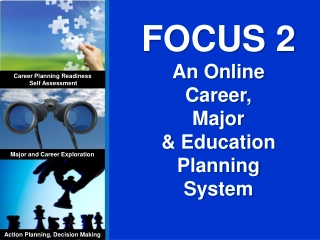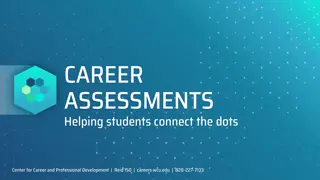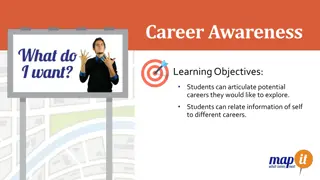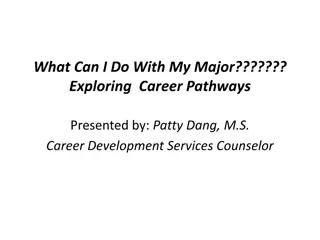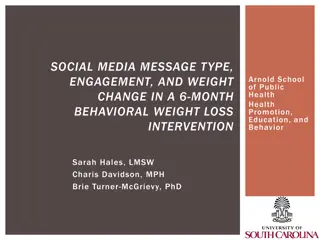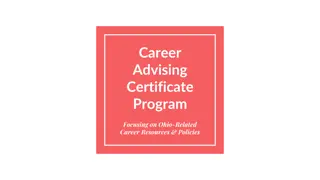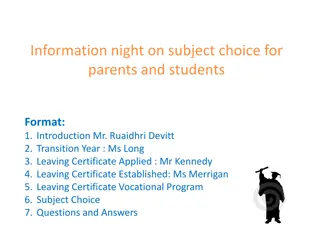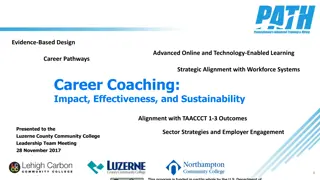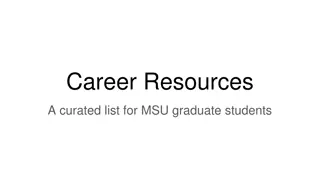
Evaluating CPWE Program Impact on Participant Career Choices
The CPWE program evaluation explores how participants' experiences influenced their career decisions, strengths, challenges, and impacts. Key findings reveal the impact on career choices, exposure to diverse patient populations, and suggestions for program improvement.
Download Presentation

Please find below an Image/Link to download the presentation.
The content on the website is provided AS IS for your information and personal use only. It may not be sold, licensed, or shared on other websites without obtaining consent from the author. If you encounter any issues during the download, it is possible that the publisher has removed the file from their server.
You are allowed to download the files provided on this website for personal or commercial use, subject to the condition that they are used lawfully. All files are the property of their respective owners.
The content on the website is provided AS IS for your information and personal use only. It may not be sold, licensed, or shared on other websites without obtaining consent from the author.
E N D
Presentation Transcript
TCMHCC External Evaluation December 2022
CPWE Program Evaluation Overall Goal: to describe CPWE fellow s experiences, particularly as they relate to the strengths, challenges, and impacts of the CPWE program In-Depth Interviews conducted with 11 CPWE Participants: (6 residents and 5 fellows) representing 10 different HRIs were interviewed as part of this Year 2 evaluation Regarding Expanding the MH Workforce in Texas: It's actually one of the things which brought me to the fellowship - having those multiple options, community reach options, which many programs still don't have across the country. Having that wide exposure to populations and settings was one reason that I chose this fellowship. -Fellow 2
Year 2 CPWE Key Findings (Qualitative) The CPWE training did not impact participants future career plans directly, but generally contributed positively to reaffirming career decisions or expanding their thinking about career options. The diversity of the population that I saw definitely changed my perspective on what I really wanted to work on and do. Not just the outpatient or inpatient settings, but even the population that I want to work with At this point, still deciding, but I'm leaning more towards community practice. - Fellow The CPWE program offers exposure to diverse patient populations that has helped prepare participants for cross-cultural interactions and culturally responsive mental health care. I just feel they're [patients] so deserving with the services and support, and they're receptive. You feel like you're part of the solution and you feel like progress is being made. You learn so much about people and their cultures and their perspectives and their motivations. That definitely is rooted in a community mental health experience more than any other psychiatric rotation experience. -Fellow 3
Year 2 CPWE Key Findings (Qualitative) The CPWE program has built the capacity of participants to serve diverse patient populations through exposure and enhancing knowledge of resources. The pathologies, the diagnoses I see in these individuals are very wide-ranging. It's rarely the same thing twice. I see a lot of individuals with different diagnoses, have different assessments, and because of that I've used a lot of different treatment modalities. That has helped me learn more about the future. PGY2 Resident Areas of improvement to the CPWE program identified by participants largely reflected the challenges experienced, which were perceived differently by residents versus fellows. Residents would like to see improvements to supports and resources, enhanced learning opportunities, and more in-person visits. I'd like for all the patients to have to come in person, but I don't think that that's unique to the CPWE program. PGY3 Resident Fellows would like the program to consider how time limitations at rotations could be addressed to the extent possible. We hate to have to change every two months. Then patients lose hope because every time they get there-- it affects rapport, it affects compliance. -Fellow 4
Year 2 CPAN Key Findings (Qualitative) Benefits of the CPAN Program (n=64) 95% indicated that accessibility to psychiatrists for quick and direct access to consultation services, information, and resources was the greatest benefit of the program. Several respondents mentioned that CPAN has increased their confidence in treating pediatric patients with mental health needs. Year 2 CPAN Survey Participation Barriers and Improvements to the CPAN Program (n=62) Greatest barrier was time constraints for making calls to CPAN were perceived as a disruption of workflow and requiring additional time built into schedules to allow for consultations. To a lesser extent, lack of buy-in and support at their clinics and the program not meeting their needs were reported as barriers. Frequently mentioned areas for improvement included: improved outreach and awareness of CPAN (31%), more implementation support and training on the program (31%), and improved connections to community resources and referrals (18%). 5
Year 2 TCHATT Key Findings (Qualitative) Year 2 TCHATT Survey Participation Benefits of the TCHATT Program (n=127) 79% indicated that accessibility of care for underserved students in need was the greatest benefit of the TCHATT program. Many respondents mentioned that TCHATT provides a level of mental health care to students that cannot be provided by school counselors alone due to specialized needs and time constraints. Improvements to the TCHATT Program (n=99) Frequently mentioned areas for improvement included: the desire for a more efficient and streamlined paperwork system (30%), better communication and follow-up (20%), more training on campus (12%), more flexibility in scheduling students (11%), and additional sessions for students (8%). Additional Comments (n=58) 31% of respondents provided positive feedback about the program and its impacts on students. 6

